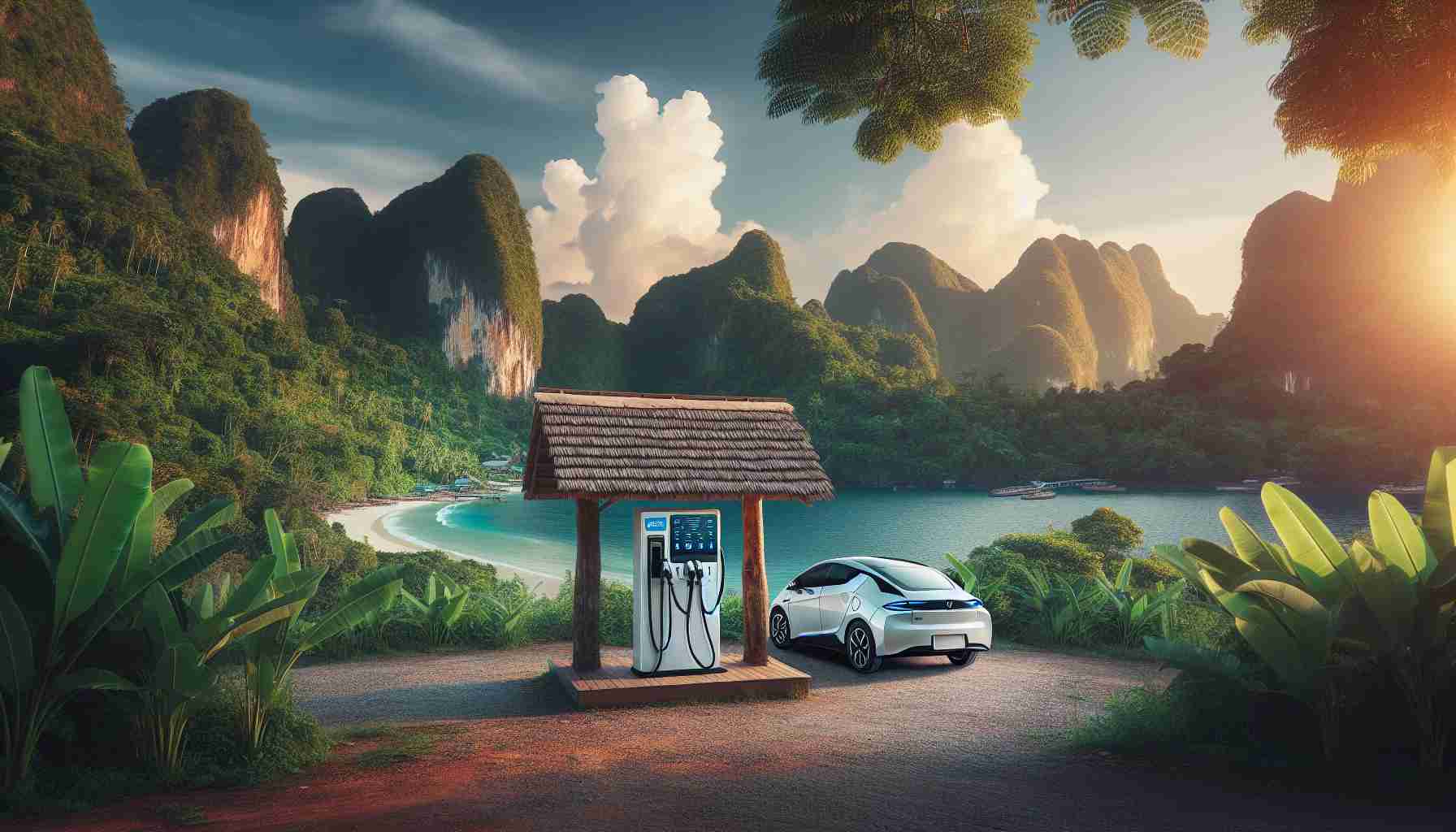Transforming Sustainability on St Helena
In an exciting partnership, Subaru UK has joined forces with Norwegian EV charger company Easee and the St Helena Government to launch a significant trial of an unprecedented electric vehicle (EV) charging point. Nestled 1,200 miles from Africa, the isolated island of St Helena is advancing toward sustainable energy and aims for zero-emissions transport by 2030.
At the core of this initiative is the Subaru Solterra, an all-electric vehicle that journeyed from the UK. Upon arrival, this versatile EV tackled the island’s rugged landscape, navigating a variety of terrains. The Solterra’s exceptional performance featured regenerative braking, efficiently managing battery usage. Remarkably, driving 50 miles on this small island utilized only 20% of its battery.
The charging station, situated near the Museum in Jamestown and linked to Connect St Helena Ltd, symbolizes a commitment to EV accessibility. Easee UK’s Managing Director highlighted that geographical challenges should not hinder EV advancement.
St Helena, once known as Napoleon’s exile and home to Jonathan, the oldest tortoise, is now determined to lead in green energy. With current renewable sources providing 25% of its power, plans are underway to ramp this up to 80% by 2028. This transition includes incentives to encourage EV adoption among residents.
The successful trial of the Solterra has sparked local interest, hinting at a bright future for sustainable transport on the island. As infrastructure develops, St Helena is set to be a pioneer in green living, one EV at a time.
Transforming Sustainability on St Helena
In a groundbreaking initiative, St Helena is charting a course towards a sustainable future by integrating electric vehicle (EV) technology with local energy sources and infrastructure. In partnership with Subaru UK and Easee, this remote island is laying the groundwork for zero-emissions transport by 2030. The implications of this project extend far beyond the shores of St Helena, with significant effects on the environment, humanity, the economy, and the future of our planet.
Electric vehicles, like the Subaru Solterra operational in St Helena, drastically reduce greenhouse gas emissions compared to traditional combustion engine vehicles. In a world struggling with climate change, this is a crucial step towards a sustainable transportation model. The island’s plan to transition to 80% renewable energy by 2028 complements the deployment of EV technology and could serve as a model for other isolated or less developed regions striving for sustainability.
The environmental benefits of such initiatives are profound. By committing to renewable sources and electric mobility, St Helena aims to decrease its reliance on fossil fuels, thereby lowering its carbon footprint significantly. The move not only reduces air pollution, which can have dire health effects on local communities, but also promotes biodiversity preservation—a crucial aspect, particularly for an island known for its unique wildlife, such as Jonathan, the world’s oldest tortoise.
On a humanitarian level, the initiative symbolizes a commitment to improving the quality of life for residents of St Helena. By fostering a culture of sustainability, the government and its partners create an environment where eco-friendly practices become the norm. As the community adopts electric vehicles, not only does it contribute to environmental goals, but it also opens up opportunities for education and engagement around sustainability—cultivating a new generation of environmentally aware citizens.
Economically, the establishment of EV infrastructure such as the charging station in Jamestown presents both challenges and opportunities. While there is an initial investment required to develop and maintain the charging infrastructure, the long-term benefits include reduced fuel costs, less dependency on imported fossil fuels, and the potential to attract eco-tourism focused on green practices. St Helena could become a beacon of sustainable tourism, appealing to visitors looking to experience and support sustainability efforts while exploring the island’s historical and ecological beauty.
Looking to the future, the success of St Helena’s EV initiative may inspire other regions, especially islands and remote communities, to follow in its footsteps. The combination of local innovation, strong partnership with international companies, and a clear commitment to sustainability serves as a blueprint for others facing similar geographical and infrastructural challenges.
A world where more regions adopt such sustainable practices contributes to global efforts in reducing carbon emissions, fighting climate change, and promoting ecological integrity. The transition to electric vehicles is not just about improving local transportation; it reflects a growing recognition that sustainable living is essential for the survival of humanity and the preservation of our planet.
In conclusion, St Helena’s journey towards becoming a pioneer in sustainable transportation is a hopeful narrative for the global community. Its efforts demonstrate that even the smallest island can make a substantial impact on achieving broader ecological goals—actions that are crucial as we forge ahead into an uncertain future.
St Helena Leads the Charge Towards a Sustainable Future with Electric Vehicles
As St Helena embarks on a groundbreaking journey towards sustainability, its recent partnership with Subaru UK and Norwegian EV charger company Easee marks a significant step towards realizing a zero-emissions transport goal by 2030. This initiative not only highlights St Helena’s commitment to renewable energy but also showcases the robust capabilities of electric vehicles (EVs) in challenging terrains.
Features of the EV Initiative
The centerpiece of this initiative is the Subaru Solterra, an all-electric SUV that has proven its mettle on the rugged landscapes of St Helena. Equipped with advanced features such as regenerative braking, the Solterra manages battery usage effectively. During its trial, the vehicle demonstrated remarkable efficiency, utilizing only 20% of its battery for a 50-mile journey across the island.
Specifications of the Subaru Solterra
– Battery Capacity: 71.4 kWh
– Range: Up to 330 miles on a full charge
– Charging Time: Approximately 30 minutes for 80% charge using a fast charger
– Performance: All-wheel drive with a 0-60 mph acceleration in 6.5 seconds
Use Cases for St Helena
1. Environmental Tourism: As a unique destination known for its historical significance and natural beauty, St Helena can leverage sustainable transportation to enhance eco-friendly tourism.
2. Local Commuting: With expanding EV infrastructure, residents can transition to electric mobility for daily transportation needs, reducing dependence on fossil fuels.
3. Public Services: The introduction of electric vehicles can also extend to public transport and government fleet vehicles, contributing to a cleaner island ecosystem.
Pros and Cons of the Initiative
Pros:
– Reduced carbon emissions and improved air quality.
– Promotion of green technologies and renewable energy practices.
– Potential economic growth through eco-tourism and sustainable development initiatives.
Cons:
– Initial high costs of EV infrastructure development.
– Possible resistance from residents accustomed to traditional fuel vehicles.
– Limited charging locations may pose challenges for widespread adoption if not adequately addressed.
Market Analysis and Predictions
As the global market shifts towards electric mobility, regions like St Helena are poised to attract attention for their novel approaches to sustainability. By 2030, it is anticipated that other remote islands and regions may follow suit, adopting similar models to enhance their energy independence and environmental stewardship.
Innovations in Renewable Energy
St Helena’s ambition to increase renewable energy sources from 25% to 80% by 2028 reflects a growing trend among small island nations to seek self-sufficiency in energy. Innovations in solar and wind energy, coupled with EV technology, are expected to create a blueprint for other isolated communities aiming to reduce their carbon footprint.
Security and Sustainability Considerations
As St Helena moves forward with its electric vehicle and renewable energy initiatives, important security aspects must be addressed. This includes safeguarding charging infrastructure from potential cyber threats and ensuring that the deployment of renewable technologies complies with environmental regulations.
Conclusion
The collaboration between Subaru, Easee, and the St Helena Government is set to not only transform the island’s transport system but also inspire global efforts towards a sustainable future. St Helena is positioning itself as a model for innovative green living, blending technology with environmental responsibility, one electric vehicle at a time.
For more insights on sustainability initiatives and electric vehicles, visit Subaru UK.













